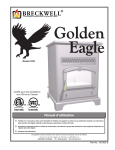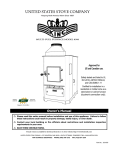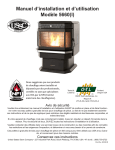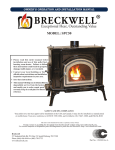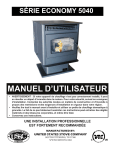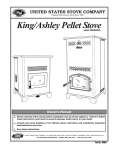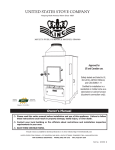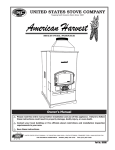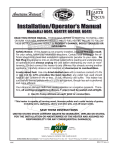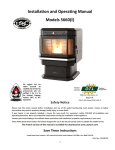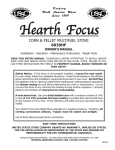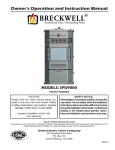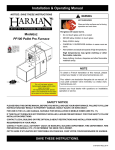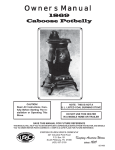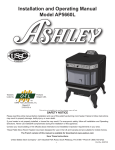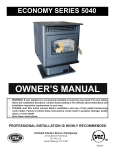Download United States Stove 5520 User's Manual
Transcript
Golden Eagle Model 5520 Certified for installations in the USA and Canada. La version française est disponible pour téléchargement à partir du site U.S. Stove: http://www. USSTOVE.com/ Owner’s Manual Please read this entire manual before installation and use of this pellet fuel-burning room heater. Failure to follow these instructions could result in property damage, bodily injury, or even death. Contact your local building or fire officials about restrictions and installation inspection in your area. Save these instructions. This unit is not intended to be used as a primary source of heat. United States Stove Company • 227 Industrial Park Rd. P.O. Box 151 South Pittsburg, TN 37380 • www.USSTOVE.com FOR TECHNICAL ASSISTANCE: PHONE: (866) 606-8444 FAX: (423) 837-2129 Part No.: 851907 E Table of Contents TABLE OF CONTENTS .............................................................................................. 2 WARRANTY REGISTRATION ................................................................................3-4 SAFETY PRECAUTIONS ........................................................................................... 5 SPECIFICATIONS....................................................................................................... 6 Heating Specifications ..................................................................................................6 Dimensions ...................................................................................................................6 Electrical Specifications ................................................................................................6 Fuel Considerations......................................................................................................6 Safety and EPA Compliance.........................................................................................6 INSTALLATION .......................................................................................................... 7 Installation Options .......................................................................................................7 Floor Protection ............................................................................................................7 Clearances ..................................................................................................................8 Venting Requirements ..................................................................................................9 Maximum Venting Distance ..........................................................................................9 Pellet Vent Type............................................................................................................9 Pellet Vent Installation ..................................................................................................9 Pellet Vent Termination .................................................................................................9 Vent Termination Clearances......................................................................................10 Through the Wall Installation ......................................................................................11 Through the Roof/Ceiling Installation .........................................................................11 Outside Air Supply ......................................................................................................12 Special Mobile Home Requirements ..........................................................................12 CONTROL PANEL .................................................................................................... 13 OPERATION ........................................................................................................14-15 Unit Preparation..........................................................................................................14 Proper Fuel .................................................................................................................14 Pre Start-up Check .....................................................................................................14 Building a Fire.............................................................................................................14 The HOT ROD Automatic Fire Starter ........................................................................15 Damper Control ..........................................................................................................15 Opening Door .............................................................................................................15 Room Air Fan..............................................................................................................15 Re-Starting a Warm Stove ..........................................................................................15 If Stove Runs Out of Fuel ...........................................................................................15 Refueling ....................................................................................................................15 Shut Down Procedure ................................................................................................15 Safety Features ..........................................................................................................15 THERMOSTAT INSTALLATION ............................................................................... 16 MAINTENANCE ...................................................................................................17-18 Exhaust System..........................................................................................................17 Interior Chambers .......................................................................................................17 Ash Disposal...............................................................................................................17 Check and Clean the Hopper .....................................................................................17 Main Door Gaskets .....................................................................................................17 Blower Motors.............................................................................................................17 Painted Surfaces ........................................................................................................17 Glass ..........................................................................................................................18 Fall Start-Up ...............................................................................................................18 Spring Shut Down.......................................................................................................18 Maintenance Schedule ...............................................................................................18 TROUBLE SHOOTING ........................................................................................19-23 REPAIR PARTS DIAGRAM/LIST ........................................................................24-26 WIRING DIAGRAM ................................................................................................... 27 2 CUT HERE WARRANTY INFORMATION CARD Name__________________________________________ Telephone #: (_____)_____________ City____________________________________________ State_______ Zip_________________ Email Address __________________________________________________________________ Model # of Unit________________________________ Serial #___________________________ Fuel Type: Wood Coal Pellet Gas Other _________________________ Place of Purchase (Retailer)______________________________________________________ City____________________________________________ State_______ Zip_________________ If internet purchase, please list website address___________________________________ Date of Purchase _______________________________________________________________ Reason for Purchase: Decoration Alternative Heat Cost Main Heat Source Other _________________________ What was the determining factor for purchasing your new U.S. stove appliance?_______ I have read the owner’s manual that accompanies this unit and fully understand the: Installation Operation and Maintenance of my new U.S. stove appliance. Print Name Signature Date Please attach a copy of your purchase receipt. Warranty not valid without a Proof of Purchase. CUT HERE Warranty information must be received within 30 days of original purchase. Detach this page from this manual, fold in half with this page to the inside and tape together. Apply a stamp and mail to the address provided. You may use an envelope if you choose. You may register online by going to www.usstove.com All information submitted will be kept strictly confidential. Information provided will not be sold for advertising purposes. Contact information will be used solely for the purpose of product notifications. 3 CUT HERE Fold Here Fold Here United States Stove Company 227 Industrial Park Rd. P.O. Box 151 South Pittsburg, TN 37380 4 CUT HERE PLACE STAMP HERE Safety Precautions circumstances and a safety concern may arise from IMPORTANT: Read this entire manual before installing sparks or fumes entering the room. and operating this product. Failure to do so may result in property damage, bodily injury, or even death. Proper Allow the stove to cool before performing any maintenance installation of this stove is crucial for safe and efficient or cleaning. Ashes must be disposed in a metal container operation. with a tight fitting lid. The closed container of ashes should be placed on a non-combustible surface or on the ground, Install vent at clearances specified by the vent well away from all combustible materials, pending final manufacturer. disposal. If a chimney or creosote fire occurs, press the “OFF” The exhaust system should be checked monthly during button immediately. Do not unplug the unit. the burning season for any build-up of soot or creosote. Do not connect the pellet vent to a vent serving any Do not touch the hot surfaces of the stove. Educate all other appliance or stove. children on the dangers of a high-temperature stove. Do not install a flue damper in the exhaust venting Young children should be supervised when they are in system of this unit. the same room as the stove. Use of outside air is not required for this unit. The hopper and stove top will be hot during operation; therefore, you should always use some type of hand Contact your local building officials to obtain a permit protection when refueling your stove. and information on any additional installation restrictions or inspection requirements in your area. A power surge protector is required. This unit must be Do not throw this manual away. This manual has important operating and maintenance instructions that you will need at a later time. Always follow the instructions in this manual. plugged into a 110 - 120V, 60 Hz grounded electrical outlet. Do not use an adapter plug or sever the grounding plug. Do not route the electrical cord underneath, in front of, or over the heater. Do not route the cord in foot traffic areas or pinch the cord under furniture. Do not plug into a GFI outlet. This appliance is designed for the use of pelletized fuel that meet or exceed the standard set by the Pellet Fuel Institute(PFI). The use of other fuels will void warranty. The heater will not operate during a power outage. If a power outage does occur, check the heater for smoke Never use gasoline, gasoline-type lantern fuel, spillage and open a window if any smoke spills into the kerosene, charcoal lighter fluid, or similar liquids to start room. or ‘freshen up’ a fire in this stove. Keep all such liquids The feed door must be closed and sealed during well away from the stove while it is in use. operation. A working smoke detector must be installed in the same Never block free airflow through the open vents of the room as this product. unit. Do not unplug the stove if you suspect a malfunction. Turn the ON/OFF SWITCH to ‘OFF’ and contact your Keep foreign objects out of the hopper. dealer. The moving parts of this stove are propelled by high torque Your stove requires periodic maintenance and cleaning (see “MAINTENANCE ”). Failure to maintain your stove may lead to improper and/or unsafe operation. electric motors. Keep all body parts away from the auger while the stove is plugged into an electrical outlet. These moving parts may begin to move at any time while the stove is plugged in. Disconnect the power cord before performing any maintenance! NOTE: Turning the ON/OFF Switch to Do not place clothing or other flammable items on or near this stove. “OFF” does not disconnect all power to the electrical components of the stove. When installed in a mobile home, the stove must be grounded directly to the steel chassis and bolted to Never try to repair or replace any part of the stove unthe floor. WARNING—THIS UNIT MUST NOT BE less instructions for doing so are given in this manual. INSTALLED IN THE BEDROOM (per HUD requirements). All other work should be done by a trained technician. CAUTION—THE STRUCTURAL INTEGRITY OF THE Do not operate your stove with the viewing door MOBILE HOME FLOOR, WALL, AND CEILING/ROOF open. The auger will not feed pellets under these MUST BE MAINTAINED. This appliance is not intended for commercial use. * This appliance is a freestanding heater. It is not intended to be attached to any type of ducting. It is not a furnace. 5 Specifications Heating Specifications Fuel Burn Rate* (lowest setting) 1.0 lbs./hr. (0.5 kg/hr) Burn Time (lowest setting) 120 hrs. (approximate) Hopper Capacity 120 lbs. (55kg) * Pellet size may effect the actual rate of fuel feed and burn times. Fuel feed rates may vary by as much as 20%. Use PFI listed fuel for best results. Dimensions Height 34 in. (864mm) Width 26 in. (660mm) Depth 27 in. (686mm) Weight 210 lbs. (95.5kg) Electrical Specifications Electrical Rating 110-120 volts, 60 HZ, 3.0 Amps Watts (operational) 175 (approx.) Watts (igniter running) 425 (approx.) FUEL CONSIDERATIONS Your pellet stove is designed to burn premium hardwood pellets that comply with Association of Pellet Fuel Industries standards. (Minimum of 40 lbs density per cubic ft, 1/4” to 5/16” diameter, length no greater than 1.5”, not less than 8,200 BTU/lb, moisture under 8% by weight, ash under 1% by weight, and salt under 300 parts per million). Pellets that are soft, contain excessive amounts of loose sawdust, have been, or are wet will result in reduced performance. Store your pellets in a dry place. DO NOT store the fuel within the installation clearances of the unit or within the space required for refueling and ash removal. Doing so could result in a house fire. SAFETY AND EPA COMPLIANCE Your pellet stove has been approved for installation in the USA and Canada. It may also be installed in a manufactured or mobile home. It has been safety tested and listed to ASTM E 1509-04, ULC-S627-00, ULC/ORD C1482-90, and(UM) 84-HUD by INTERTEK Testing Services in Fairview, Oregon USA. 6 Installation INSTALLATION OPTIONS Read this entire manual before you install and use your pellet stove. Failure to follow instructions may result in property damage, bodily injury, or even death! (See specific installation details for clearances and other installation requirements) A Freestanding Unit—supported by pedestal/legs and placed on a non-combustible floor surface in compliance with clearance requirements for a freestanding stove installation. An Alcove Unit—supported by pedestal/legs and placed on a non-combustible floor surface in compliance with clearance requirements for an alcove installation. Your pellet stove may be installed to code in either a conventional or mobile home (see SPECIAL MOBILE HOME REQUIREMENTS). The installation must comply with the Manufactured Home and Safety Standard (HUD), CFR3280, Part 24. It is recommended that only a authorized technician install your pellet stove, preferably an NFI certified specialist. CAUTION: DO NOT CONNECT TO OR USE IN CONJUNCTION WITH ANY AIR DISTRIBUTION DUCTWORK UNLESS SPECIFICALLY APPROVED FOR SUCH INSTALLATIONS. IMPROPER INSTALLATION: The manufacturer will not be held responsible for damage caused by the malfunction of a stove due to improper venting or installation. Call (800) 750-2723 and/or consult a professional installer if you have any questions. FLOOR PROTECTION This unit must be installed on a 1/2” thick, non-combustible floor protector with a k-value of 0.042. A 1” thick protector with a k-value of 0.084 is also acceptable. The floor protector should be large enough to extend a minimum of 6 in. (152.4mm) in front, 6 in. (152.4mm) on each side, and 1 in. (25.4mm) behind the stove (see FIGURE 1). Floor protection must extend under and 2 in. (50.8mm) to each side of the chimney tee for an interior vertical installation (see FIGURE 2). Your pellet stove will need a minimum 31” (787mm) x 38” (965mm) floor protector. 7 Installation CLEARANCES Your pellet stove has been tested and listed for installation in residential, mobile home, and alcove applications in accordance with the clearances given in FIGURES 3-5 and TABLE 1. Any reduction in clearance to combustibles may only be done by means approved by a regulatory authority. NOTE: Distance “C” on the left-hand side of your pellet stove may need to be greater than the minimum required clearance for suitable access to the control panel. FIGURE 3 FIGURE 4 SIDEWALL CLEARANCES PARALLEL INSTALLATION SIDEWALL CLEARANCES CORNER INSTALLATION PARALLEL CORNER ALCOVE A - Backwall to unit B - Sidewall to flue C - Sidewall to top edge of unit D - Adjacent wall to unit E - Alcove depth F - Alcove height TABLE 1 CLEARANCES FIGURE 5 ALCOVE CLEARANCES 8 3.00 / 76mm 16.00 / 406mm 12.00 / 305mm 1.00 / 25.4mm 36.00 - 914mm 60.00 - 1520mm Installation VENTING REQUIREMENTS Install vent at clearances specified by the vent manufacturer. Do not connect the pellet vent to a vent serving any other appliance or stove. Do not install a flue damper in the exhaust venting system of this unit. The following installation guidelines must be followed to ensure conformity with both the safety listing of this stove and to local building codes. Do not use makeshift methods or compromise in the installation. IMPORTANT! This unit is equipped with a negative draft system that pulls air through the burn pot and pushes the exhaust out of the dwelling. If this unit is connected to a flue system other than the way explained in this manual, it will not function properly. MAXIMUM VENTING DISTANCE Installation MUST include at least 3-feet of vertical pipe outside the home. This will create some natural draft to reduce the possibility of smoke or odor during appliance shutdown and keep exhaust from causing a nuisance or hazard by exposing people or shrubs to high temperatures. The maximum recommend vertical venting height is 12-feet for 3-inch type “PL” vent. Total length of horizontal vent MUST NOT exceed 4-feet. This could cause back pressure. Use no more than 180 degrees of elbows (two 90-degree elbows, or two 45-degree and one 90-degree elbow, etc.) to maintain adequate draft. PELLET VENT TYPE A UL listed 3-inch or 4-inch type “PL” pellet vent exhaust system must be used for installation and attached to the pipe connector provided on the back of the stove (use a 3-inch to 4-inch adapter for 4-inch pipe). Connection at back of stove must be sealed using Hi-Temp RTV. Use 4-inch vent if the vent height is over 12-feet or if the installation is over 2,500 feet above sea level. We recommend the use of Simpson Dura-Vent® or Metal-Fab® pipe (if you use other pipe, consult your local building codes and/or building inspectors). Do not use Type-B Gas Vent pipe or galvanized pipe with this unit. The pellet vent pipe is designed to disassemble for cleaning and should be checked several times during the burning season. Pellet vent pipe is not furnished with the unit and must be purchased separately. PELLET VENT INSTALLATION The installation must include a clean-out tee to enable collection of fly ash and to permit periodic cleaning of the exhaust system. The clean-out tee must be installed at the base of the vertical section, not in horizontal section. 90-degree elbows accumulate fly ash and soot thereby, reducing exhaust flow and performance of the stove. Each elbow or tee reduces draft potential by 30% to 50%. All joints in the vent system must be fastened by at least 3 screws, and all joints must be sealed with Hi-Temp RTV silicone sealant on the inside and high temperature tape on the outside to be airtight. The area where the vent pipe penetrates to the exterior of the home must be sealed with silicone or other means to maintain the vapor barrier between the exterior and the interior of the home. Vent surfaces can get hot enough to cause burns if touched by children. Noncombustible shielding or guards may be required. PELLET VENT TERMINATION Do not terminate the vent in an enclosed or semi-enclosed area, such as; carport, garage, attic, crawl space, under a sundeck or porch, narrow walkway, or any other location that can build up a concentration of fumes. The termination must exhaust above the outside air inlet elevation. The termination must not be located where it will become plugged by snow or other materials. Do not terminate the venting into an existing steel or masonry chimney. 9 Installation VENT TERMINATION CLEARANCES: A) Minimum 4-feet (1.22m) clearance below or beside any door or window that opens. B) Minimum 1-foot (0.3m) clearance above any door or window that opens. C) Minimum 3-feet (0.91m) clearance from any adjacent building. D) Minimum 7-feet (2.13m) clearance from any grade when adjacent to public walkways. E) Minimum 2-feet (0.61m) clearance above any grass, plants, or other combustible materials. F) Minimum 3-feet (0.91m) clearance from an forced air intake of any appliance. G) Minimum 2-feet (0.61m) clearance below eves or overhang. H) Minimum 1-foot (0.3m) clearance horizontally from combustible wall. I) Must be a minimum of 3 feet (0.91m) above the roof and 2 feet (0.61m) above the highest point or the roof within 10 feet (3.05m). G FIGURE 6 VENT TERMINATION CLEARANCES 10 Installation THROUGH THE WALL INSTALLATION (RECOMMENDED INSTALLATION) Canadian installations must conform to CAN/CSA-B365. To vent the unit through the wall, connect the pipe adapter to the exhaust motor adapter. If the exhaust adapter is at least 18 in.(457mm) above ground level, a straight section of pellet vent pipe can be used through the wall. Your heater dealer should be able to provide you with a kit that will handle most of this installation, which will include a wall thimble that will allow the proper clearance through a combustible wall. Once outside the structure, a 3 in.(76mm) clearance should be maintained from the outside wall and a clean out tee should be placed on the pipe with a 90-degree turn away from the house. At this point, a 3ft (0.91m) (minimum) section of pipe should be added with a horizontal cap, which would complete the installation (see FIGURE 7). A support bracket should be placed just below the termination cap or one every 4ft (1.22m) to make the system more stable. If you live in an area that has heavy snowfall, it is recommended that the installation be taller than 3ft (0.91m) to get above the snowdrift line. This same installation can be used if your heater is below ground level by simply adding the clean-out section and vertical pipe inside until ground level is reached. With this installation you have to be aware of the snowdrift line, dead grass, and leaves. We require a 3ft (0.91m) minimum vertical rise on the inside or outside of the house. FIGURE 7 TYPICAL THROUGH THE WALL INSTALLATION The “through the wall” installation is the least expensive and simplest installation. Never terminate the end vent under a deck, in an alcove, under a window, or between two windows. We recommend Simpson Dura-Vent® or Metal-Fab® kits. THROUGH THE ROOF/CEILING INSTALLATION When venting the heater through the ceiling, the pipe is connected the same as through the wall, except the clean-out tee is always on the inside of the house, and a 3 in.(76mm) adapter is added before the clean-out tee. You must use the proper ceiling support flanges and roof flashing (supplied by the pipe manufacturer; follow the pipe manufacturer’s directions). It is important to note that if your vertical run of pipe is more than 12ft (3.66m), the pellet vent pipe size should be increased to 4 in. (102mm) in diameter. Do not exceed more than 4ft (1.22m) of pipe on a horizontal run and use as few elbows as possible. If an offset is required, it is better to install 45-degree elbows rather than 90-degree elbows. 11 Installation OUTSIDE AIR SUPPLY (optional, unless installing in a mobile home) or an airtight home Depending on your location and home construction, outside air may be necessary for optimal performance. Metal pipe (solid or flexible) must be used for the outside air installation. PVC pipe is NOT approved and should NEVER be used. A wind shield over the termination of the outside air pipe or a 90-degree elbow or bend away from the prevailing winds MUST be used when an outside air pipe is installed through the side of a building. The outside air termination MUST be at least 1ft (0.305m) away from the exhaust system termination. The outside air pipe on your heater is 2” (50.8mm) OD. The outside air connecting pipe must be at least 2” (50.8mm) ID. The outside air connection used MUST NOT restrict the amount of air available to your heater. The outside air connecting pipe must be as short and free of bends as possible, and it must fit over, not inside, the outside air connection to the heater. FIGURE 9 TYPICAL FRESH AIR TERMINATION FIGURE 8 EXHAUST/INLET LOCATIONS NOTE: Dimensions from the floor to your stoves inlet/exhaust pipes are approximate and may vary depending on your installation. SPECIAL MOBILE HOME REQUIREMENTS WARNING! - DO NOT INSTALL IN A SLEEPING ROOM CAUTION! - THE STRUCTURAL INTEGRITY OF THE MOBILE HOME FLOOR, WALL, AND CEILING/ROOF MUST BE MAINTAINED. A working smoke detector must be installed in the same room as this product. It must be installed at least 15 feet (4,57 m) from the appliance in order to prevent undue triggering of the detector when reloading. In addition to the previously detailed installation requirements, mobile home installations must meet the following requirements: • The heater must be permanently bolted to the floor through provided holes in the base. • The heater must be electrically grounded to the steel chassis of the mobile home with 8 GA copper wire using a serrated or star washer to penetrate paint or protective coating to ensure grounding. • Vent must be 3 or 4-inch “PL” Vent and must extend a minimum or 36 in.(914mm) above the roof line of the mobile home and must be installed using a UL listed ceiling fire stop and rain cap. • When moving your mobile home, all exterior venting must be removed while the mobile home is being relocated. After relocation, all venting must be reinstalled and securely fastened. • Outside Air is mandatory for mobile home installation. See your dealer for purchasing or call customer service. • Check with your local building officials as other codes may apply. 12 Control Panel PANEL CONTROLS The blowers and automatic fuel supply are controlled from a panel on the left side of the appliance. The control panel functions are as follows: A. ON/OFF SWITCH • When pushed the stove will automatically ignite. No other firestarter is necessary. The igniter will stay on for at least 10 and up to 15 minutes, depending on when Proof of Fire is reached. The fire should start in about 5 minutes. • The green light located above the On/Off button (in the On/Off box) will flash during the ignition start-up period. • The Heat Level Advance is inoperable during the ignition start period. When the green light continuously stays on, the Heat Level Advance can be adjusted to achieve the desired heat output. To manually ignite in case of ignitor failure. Place a handful of pellets in the burnpot. Add starter gel for pellet stoves, ignite, close door, turn the unit on.. Replace the ignitor as soon as possible. NOTE: If the stove has been shut off, and you want to re-start it while it is still warm, the “on/off” button must be held down for 2 seconds. B. FUEL FEED SWITCH • When the “Fuel Feed” button is pushed and held down, the stove will feed pellets continuously into the burn pot. • While the stove’s auger system is feeding pellets, the green light (in the “Fuel Feed” box) will be on. CAUTION: DO NOT USE THIS CONTROL DURING NORMAL OPERATION BECAUSE IT COULD SMOTHER THE FIRE AND LEAD TO A DANGEROUS SITUATION. C. HIGH FAN SWITCH • The room air fan speed varies directly with the feed rate. The “HIGH FAN” switch overrides this variable speed function. It will set the room air blower speed to high at any feed rate setting. • When the “HIGH FAN” button is pushed, the room air fan will switch to its highest setting. • When this button is pushed again, the room air fan will return to its original setting based on the Heat Level Advance setting. D. RESET TRIM Different size and quality pellet fuel may require adjustment of the “1” feed setting on the Heat Level Advance bar graph. This is usually a one-time adjustment based on the fuel you are using. The “RESET TRIM” button when adjusted will allow for 3 different feed rate settings for the #1 feed setting only. To adjust simply push the “RESET TRIM” button while the stove is operating at setting “1” and watch the bar graph. • When the “1” & “3” lights are illuminated on the bar graph the low feed rate is at its “lowest” setting. (Approx. 0.9 pounds per hour) • When the “1” light is illuminated on the bar graph, the low feed rate is at its “normal” setting. • When the “1” & “4” lights are illuminated on the bar graph, the low feed rate is at its “highest” setting. NOTE: When the stove is set on “1” the “reset trim” values will be shown on the Heat Level Advance bar graph. For example if the Reset Trim is set to its lowest setting every time the stove is set to low the “1” and “3” lights will be illuminated on the bar graph. E. HEAT LEVEL ADVANCE • This button, when pushed, will set the pellet feed rate, hence the heat output of your stove. The levels of heat output will incrementally change on the bar graph starting from level “1” to “4”. NOTE: When dropping 3 or more heat level settings (4 to 1,) push the ‘High Fan’ button and allow the room air fan to run at that setting for at least 5 minutes to prevent the stove from tripping the high temp thermodisc. If the high temp thermodisc does trip, see “SAFETY FEATURES”. 13 Operation DO NOT USE CHEMICALS OR FLUIDS TO START THE FIRE - Never use gasoline, gasoline-type lantern fuel, kerosene, charcoal lighter fluid, or similar liquids to start or “freshen up” a fire in this stove. Keep all such liquids well away from the stove while it is in use. DO NOT BURN GARBAGE OR FLAMMABLE FLUIDS SUCH AS GASOLINE, NAPHTHA, OR ENGINE OIL. HOT WHILE IN OPERATION. KEEP CHILDREN, CLOTHING AND FURNITURE AWAY. CONTACT MAY CAUSE SKINS BURNS. DO NOT USE GRATES OR ELEVATE THE FIRE. BUILD FIRE DIRECTLY ON HEARTH. DO NOT OVERFIRE - IF HEATER OR CHIMNEY CONNECTOR GLOWS, YOU ARE OVERFIRING. PROPER FUEL THIS STOVE IS APPROVED FOR BURNING PELLETIZED WOOD FUEL ONLY! Factory-approved pellets are those 1/4” or 5/16” in diameter and not over 1” long. Longer or thicker pellets sometimes bridge the auger flights, which prevents proper pellet feed. Burning wood in forms other than pellets is not permitted. It will violate the building codes for which the stove has been approved and will void all warranties. The design incorporates automatic feed of the pellet fuel into the fire at a carefully prescribed rate. Any additional fuel introduced by hand will not increase heat output but may seriously impair the stoves performance by generating considerable smoke. Do not burn wet pellets. The stove’s performance depends heavily on the quality of your pellet fuel. Avoid pellet brands that display these characteristics: a. Excess Fines – “Fines” is a term describing crushed pellets or loose material that looks like sawdust or sand. Pellets can be screened before being placed in hopper to remove most fines. b. Binders – Some pellets are produced with materials to hold the together or “bind” them. c. High ash content – Poor quality pellets will often create smoke and dirty glass. They will create a need for more frequent maintenance. You will have to empty the burn pot plus vacuum the entire system more often. Poor quality pellets could damage the auger. United States Stove Co. cannot accept responsibility for damage due to poor quality pellets. PRE-START-UP CHECK Remove burn pot, making sure it is clean and none of the air holes are plugged. Clean the firebox, and then reinstall burn pot. Clean door glass, if necessary (a dry cloth or paper towel is usually sufficient). Never use abrasive cleaners on the glass or door. Check fuel in the hopper, and refill if necessary. NOTE: The 5520 Hopper can hold up to 120 lbs. of pellets. BUILDING A FIRE Never use a grate or other means of supporting the fuel. Use only the burn pot supplied with this heater. Hopper lid must be closed in order for the unit to feed pellets. If it is the first time you have started the unit, or anytime the hopper has been emptied of pellets, it will be necessary to prime the auger. In order to prime the auger press and hold the fuel feed button after starting the unit. Keep fuel feed button depressed until pellets begin to fall into the burn pot, then release the fuel feed button and allow the unit to operate normally. During the start up period: 1) DO NOT open the viewing door. 2) DO NOT open the damper more than 1/4”. 3) DO NOT add pellets to the burn pot by hand. 4) DO NOT use the Fuel Feed button (unless you are priming the auger after running out of pellets). A dangerous condition could result. NOTE: During the first few fires, your stove will emit an odor as the high temperature paint cures or becomes seasoned to the metal. Maintaining smaller fires will minimize this. Avoid placing items on stove top during this period because paint could be affected. THE HOTROD AUTOMATIC FIRESTARTER a. Fill hopper and clean burn pot. b. Press “On/Off” button. Make sure light is on. c. The damper should be completely closed or open no more than 1/4” during start-up. This will vary depending on your installation and elevation. Once fire is established adjust for desired flame increasing the amount the damper is open as the heat setting is increased. (See “DAMPER CONTROL”) 14 Operation d. Adjust feed rate to desired setting by pressing “Heat Level Advance” button. If fire doesn’t start in 15 minutes, press “On/Off”, wait a few minutes, clear the burn pot, and start procedure again. DAMPER CONTROL The damper control rod on the stove’s lower left side adjusts the combustion air. This control is necessary due to the varied burn characteristics of individual installations, different pellet brands and pellet feed rates. It allows you to improve the efficiency of your stove. Providing correct combustion air will reduce the frequency of cleaning your glass door and prevent the rapid buildup of creosote inside your stove and chimney. You should adjust the damper based on the fire’s appearance. A low, reddish, dirty fire can be improved by pulling the damper out slightly. A “blow torch” fire can be improved by pushing the damper in a bit. As a general rule, on lower feed rate settings, the damper should be in farther. On higher feed rates, the damper should be more open. Through trial and error, you will find the best setting. Consult your dealer if you need help. NOTE: On “1”, damper should be either completely closed or out approximately 1/8” to 1/4”. If damper is out too far, it can cause the fire to go out. OPENING DOOR If the door is opened while the stove is in operation it must be closed within 30 seconds or the stove will shut down. If the stove shuts down push the “On/Off” button to re-start your stove. ROOM AIR FAN When starting your stove the Room Air Fan will not come on until the stove’s heat exchanger warms up. This usually takes about 10 minutes from start-up. RE-STARTING A WARM STOVE If the stove has been shut off, and you want to re-start it while it is still warm, the “on/off” button must be held down for 2 seconds. IF STOVE RUNS OUT OF PELLETS The fire goes out and the auger motor and blowers will run until the stove cools. This will take 30 to 45 minutes. After the stove components stop running the “On/Off” and the BAR GRAPH lights stay on for 10 minutes. After the 10 minutes the “3” light on the bar graph will flash and the “On/Off” light will go off. To restart, refill hopper and press “Fuel Feed” button until pellets begin to fall into burn pot. Press “On/Off” button. REFUELING The hopper and stove top will be hot during operation; therefore, you should always use some type of hand protection when refueling your stove. Never place your hand near the auger while the stove is in operation. We recommend that you not let the hopper drop below ¼ full. KEEP HOPPER LID CLOSED AT ALL TIMES EXCEPT WHEN REFILLING. DO NOT OVERFILL HOPPER. SHUTDOWN PROCEDURE WARNING: Never shut down this unit by unplugging it from the power source. Turning your stove off is a matter of pressing the “On/Off” control panel switch. The red light will go out. The blowers will continue to operate until internal firebox temperatures have fallen to a preset level. SAFETY FEATURES a. Your stove is equipped with a high temperature thermodisc. This safety switch has two functions. 1. To recognize an overheat situation in the stove and shut down the fuel feed or auger system. 2. In case of a malfunctioning convection blower, the high-temperature thermodisc will automatically shut down the auger, preventing the stove from overheating. NOTE: On some units, once tripped, like a circuit breaker, the reset button will have to be pushed before restarting your stove. On other units the thermodisc has no reset button and will reset itself once the stove has cooled. The manufacturer recommends that you call your dealer if this occurs as this may indicate a more serious problem. A service call may be required. b. If the combustion blower fails, an air pressure switch will automatically shut down the auger. 15 NOTE: Opening the stove door for more than 30 seconds during operation will cause enough pressure change to activate the air switch, shutting the fuel feed off. Close the door and press “On/Off” button to continue operation of your stove. Thermostat Installation OPTIONAL THERMOSTAT A optional thermostat may help you maintain a constant house temperature automatically. A millivolt thermostat is required. A fixed wall mount or hand held model can be used. The control panel can be set up two ways to operate your stove in thermostat mode. THERMOSTAT INSTALLATION • A MILLIVOLT NON-PROGRAMMABLE THERMOSTAT IS REQUIRED. • Unplug stove from power outlet. • Remove control board from stove. • The two thermostat wires connect to the terminal block on the lower left side of the back of the control board. • Insert the wires in the terminal side and tighten the two screws. MODES TO SWITCH BETWEEN ANY OF THE THREE MODES THE STOVE MUST BE SHUT OFF, THE NEW MODE SELECTED, AND THE STOVE RESTARTED. MANUAL MODE • USE THIS MODE EXCLUSIVELY IF YOU DO NOT CONNECT AN OPTIONAL THERMOSTAT. • In this mode the stove will operate only from the control panel as detailed in the “OPERATION” section of this owner’s manual. HIGH/LOW THERMOSTAT MODE • USE THIS MODE ONLY IF YOU CONNECT A THERMOSTAT. • When engaged in this mode the stove will automatically switch between two settings. When warm enough, it will switch to the #1 or low setting. The room air blower will also slow to its lowest speed. • The Heat Level Advance setting on the bar graph will stay where it was initially set. When the house cools below the thermostat setting, the stove will switch to the feed rate of the heat level advance setting. ON/OFF THERMOSTAT MODE (Ignitor life will be cut down in this mode) • USE THIS MODE ONLY IF YOU CONNECT A THERMOSTAT. • In this mode, when the home is warm enough the stove will shut off. The fans will continue to run until the stove cools. • When the home cools below the thermostat setting, the stove will automatically restart and run at the last feed rate setting. NOTE: When in “high/low” or “on/off” thermostat mode – • Do not operate the stove higher than the #3 setting. • Set damper control rod approximately 1/4” to 1/2” out. This will vary depending on elevation and weather conditions. Observe stoves operation and adjust damper as necessary. 16 On/Off High/Low Manual Maintenance Failure to clean and maintain this unit as indicated can result in poor performance and safety hazards. Unplug your stove’s electrical cord prior to removing the back panel or opening the exhaust system for any inspection, cleaning, or maintenance work. Never perform any inspections, cleaning, or maintenance on a hot stove. Do not operate stove with broken glass , leakage of flue gas may result. WARNING THE CHIMNEY AND CHIMNEY CONNECTOR MUST BE KEPT IN GOOD CONDITION AND CLEAN. EXHAUST SYSTEM Creosote Formation – When any wood is burned slowly, it produces tar and other organic vapors, which combine with expelled moisture to form creosote. The creosote vapors condense in the relatively cool chimney flue or a newly started fire or from a slow-burning fire. As a result, creosote residue accumulates on the flue lining. When ignited, this creosote makes an extremely hot fire, which may damage the chimney or even destroy the house. Despite their high efficiency, pellet stoves can accumulate creosote under certain conditions. Soot and Flyash: Formation and Need for Removal- The products of combustion will contain small particles of flyash. The flyash will collect in the exhaust venting system and restrict the flow of the flue gases. Incomplete combustion, such as occurs during startup, shutdown, or incorrect operation of the room heater will lead to some soot formation which will collect in the exhaust venting system. The exhaust venting system should B e inspected at least once every year to determine if cleaning is necessary. Inspection and Removal – The chimney connector and chimney should be inspected annually or per ton of pellets to determine if creosote or fly ash build-up has occurred. If creosote has accumulated, it should be removed to reduce the risk of a chimney fire. Inspect the system at the stove connection and at the chimney top. Cooler surfaces tend to build creosote deposits quicker, so it is important to check the chimney from the top as well as from the bottom. The creosote should be removed with a brush specifically designed for the type of chimney in use. A qualified chimney sweep can perform this service. It is also recommended that before each heating season the entire system be professionally inspected, cleaned and, if necessary, repaired. To clean the chimney, disconnect the vent from the stove. INTERIOR CHAMBERS Periodically remove and clean the burn pot and the area inside the burn pot housing. In particular it is advisable to clean out the holes in the burn pot to remove any build up that may prevent air from moving through the burn pot freely. Remove the two(2) plates on each side of the burn pot housing and clean out that rear chamber. If a vacuum is used to clean your stove, we suggest using a vacuum designed for ash removal. Some regular vacuum cleaner (i.e. shop vacs) may leak ash into the room. ASH DISPOSAL Ashes should be placed in a metal container with a tight fitting lid. The closed container of ashes should be placed on a noncombustible floor or on the ground, well away from all combustible materials, pending final disposal. If the ashes are disposed of by burial in soil or otherwise locally dispersed, they should be retained in the closed container until all cinders have been thoroughly cooled. The container shall not be used for other trash or waste disposal. CHECK AND CLEAN THE HOPPER Check the hopper periodically to determine if there is any sawdust or pellets that are sticking to the hopper surface. Clean as needed. DOOR AND GLASS GASKETS Inspect the main door and glass window gaskets periodically. The main door may need to be removed to have frayed, broken, or compacted gaskets replaced by your authorized dealer. The glass gasket has a gap at the bottom for the airwash. BLOWER MOTORS Clean the air holes on the motors of both the exhaust and distribution blowers annually. Remove the exhaust blower from the exhaust duct and clean out the internal fan blades and housing as part of your fall start-up. PAINTED SURFACES Painted surfaces may be wiped down with a damp cloth. If scratches appear, or you wish to renew your paint, contact your authorized dealer to obtain a can of suitable high-temperature paint. 17 Maintenance GLASS - Cleaning, Removal and Replacement of Broken Door Glass Cleaning - We recommend using a high quality glass cleaner. Should a build up of creosote or carbon accumulate, you may wish to use 000 steel wool and water to clean the glass. DO NOT use abrasive cleaners. DO NOT perform the cleaning while the glass is HOT. , In the event you need to replace the glass, remove the six(6) screws and glass retainers. While wearing leather gloves (or any other gloves suitable for handling broken glass), carefully remove any loose pieces of glass from the door frame. Dispose of all broken glass properly. ONLY high temperature ceramic glass of the correct size and thickness may be used. DO NOT substitute alternative materials for the glass. Contact your authorized dealer to obtain this glass. Re-install the new glass by re-attaching the retainers and screws, careful not to overtighten the screws for this could damage the glass. DO NOT abuse the door glass by striking, slamming or similar trauma. Do not operate the stove with the glass removed, cracked or broken. FALL START UP Prior to starting the first fire of the heating season, check the outside area around the exhaust and air intake systems for obstructions. Clean and remove any fly ash from the exhaust venting system. Clean any screens on the exhaust system and on the outside air intake pipe. Turn all of the controls on and make sure that they are working properly. This is also a good time to give the entire stove a good cleaning throughout. SPRING SHUTDOWN After the last burn in the spring, remove any remaining pellets from the hopper and the auger feed system. Scoop out the pellets and then run the auger until the hopper is empty and pellets stop flowing (this can be done by pressing the “ON” button with the viewing door open). Vacuum out the hopper. Thoroughly clean the burn pot, and firebox. It may be desirable to spray the inside of the cleaned hopper with an aerosol silicone spray if your stove is in a high humidity area. The exhaust system should be thoroughly cleaned. MAINTENANCE SCHEDULE Use the following as a guide under average use conditions. Gaskets around door and door glass should be inspected and repaired or replaced when necessary. Burn Pot Daily Weekly Stirred Empty Combustion Chamber Brushed Ashes Check Interior Chambers Empty Vacuumed Combustion Blower Blades Vacuumed / Brushed Convection Blower Impeller Vacuumed / Brushed Vent System Cleaned Gaskets Glass Hopper (end of season) 18 Monthly or as needed Inspected Wiped Cleaned Emptied and vacuumed Trouble Shooting Guide When your stove acts out of the ordinary, the first reaction is to call for help. This guide may save time and money by enabling you to solve simple problems yourself. Problems encountered are often the result of only five factors: 1) poor fuel; 2) poor operation or maintenance; 3) poor installation; 4) component failure; 5) factory defect. You can usually solve those problems related to 1 and 2. Your dealer can solve problems relating to 3, 4 and 5. Refer to the diagrams to help locate indicated parts. For the sake of troubleshooting and using this guide to assist you, you should look at your heat level setting to see which light is flashing. Disconnect the power cord before performing any maintenance! NOTE: Turning the ON/OFF Switch to “OFF” does not disconnect all power to the electrical components of the stove. Never try to repair or replace any part of the stove unless instructions for doing so are given in this manual. All other work should be done by a trained technician. STOVE SHUTS OFF AND THE #2 LIGHT FLASHES Possible Causes: Possible Remedies: (Unplug stove first when possible) 1. Airflow switch hose or stove attachment pipes for hose are blocked. Unhook air hose from the air switch and blow through it. If air flows freely, the hose and tube are fine. If air will not flow throw the hose, use a wire coat hanger to clear the blockage. 2. The air inlet, burnpot, interior combustion air chambers, combustion blower, or exhaust pipe are blocked with ash or foreign material. Follow all cleaning procedures in the maintenance section of the owner’s manual. 3. The firebox is not properly sealed. Make sure the door is closed and that the gasket is in good shape. If the ash door has a latch, make sure the ash door is properly latched and the gasket is sealing good. If the stove has just a small hole for the ashes to fall through under the burnpot, make sure the slider plate is in place to seal off the firebox floor. 4. Vent pipe is incorrectly installed. Check to make sure vent pipe installation meets criteria in owner’s manual. 5. The airflow switch wire connections are bad. Check the connectors that attach the gray wires to the air switch. 6. The gray wires are pulled loose at the Molex connector on the wiring harness. Check to see if the gray wires are loose at the Molex connector. 7. Combustion blower failure. With the stove on, check to see if the combustion blower is running. If it is not, you will need to check for power going to the combustion blower. It should be a full current. If there is power, the blower is bad. If there is not, see #8. 8. Control board not sending power to combustion blower. If there is no current going to the combustion blower, check all wire connections. If all wires are properly connected, you have a bad control board. 9. Control board not sending power to air switch. There should be a 5-volt current (approximately) going to the air switch after the stove has been on for 30 seconds. 10. Air switch has failed (very rare). To test the air switch, you will need to disconnect the air hose from the body of the stove. With the other end still attached to the air switch, very gently suck on the loose end of the hose (you may want to remove the hose entirely off the stove and the air switch first and make sure it is clear). If you hear a click, the air switch is working. BE CAREFUL TOO MUCH VACUUM CAN DAMAGE THE AIR SWITCH. 19 Trouble Shooting Guide STOVE SHUTS OFF AND THE #3 LIGHT FLASHES Possible Causes: Possible Remedies: (Unplug stove first when possible) 1. The hopper is out of pellets. Refill the hopper. 2. The air damper is too far open for a low feed setting. If burning on the low setting, you may need to close the damper all the way (push the knob in so it touches the side of the stove). 3. The burnpot is not pushed completely to the rear of the firebox. Make sure that the air intake collar on the burnpot is touching the rear wall of the firebox. 4. The burnpot holes are blocked. Remove the burnpot and thoroughly clean it. 5. The air inlet, the interior chambers, or exhaust system has a partial blockage. Follow all cleaning procedures in the maintenance section of the owner’s manual. 6. The hopper safety switch has failed or hopper is open. When operating the unit, be sure the hopper lid is closed so that the hopper safety switch will activate. Check the wires leading from the hopper safety switch to the control panel and auger motor for secure connections. Use a continuity tester to test the hopper safety switch; replace if necessary. 7. The auger shaft is jammed. Start by emptying the hopper. Then remove the auger motor by removing the auger pin. Remove the auger shaft inspection plate in the hopper so that you can see the auger shaft. Gently lift the auger shaft straight up so that the end of the auger shaft comes up out of the bottom auger bushing. Next, remove the two nuts that hold the top auger biscuit in. Then rotate the bottom end of the auger shaft up towards you until you can lift the shaft out of the stove. After you have removed the shaft, inspect it for bent flights, burrs, or broken welds. Remove any foreign material that might have caused the jam. Also, check the auger tube for signs of damage such as burrs, rough spots, or grooves cut into the metal that could have caused a jam. 8. The auger motor has failed. Remove the auger motor from the auger shaft and try to run the unit. If the motor will turn the shaft is jammed on something. If the motor will not turn, the motor is bad. 9. The Proof of Fire (POF) thermodisc has malfunctioned. Temporarily bypass the POF thermodisc by disconnecting the two brown wires and connecting them with a short piece of wire. Then plug the stove back in. If the stove comes on and works, you need to replace the POF thermodisc. This is for testing only. DO NOT LEAVE THE THERMODISC BYPASSED. Your blowers will never shut off and if the fire went out, the auger will continue to feed pellets until the hopper is empty if you leave the POF thermodisc bypassed. 10. The high limit thermodisc has tripped or is defective. Wait for the stove to cool for about 30 - 45 minutes. Locate the High Limit thermodisc and press the reset button on the back of it. If the heater will not restart, check the thermodisc to see if it’s bad. To test if the thermodisc is bad, you can bypass it as described previously for the POF thermodisc. 11. The fuse on the control board has blown. Remove the control board. On the back there is one fuse. If it appears to be bad, replace it with a 5 Amp, 125 Volt fuse. Plug the stove back in and try to run the unit. 12. The control board is not sending power to the POF thermodisc or other auger system components. There should be a 5-volt (approximately) current going to the POF thermodisc after the stove has been on for 10 minutes. 20 Trouble Shooting Guide STOVE FEEDS PELLETS, BUT WILL NOT IGNITE Possible Causes: Possible Remedies: (Unplug stove first when possible) 1. Air damper open too far for ignition. Push the air damper in closer to the side of the stove for startup. In some situations it may be necessary to have the damper completely closed for ignition to take place. After there is a flame, the damper can then be adjusted for the desired feed setting. 2. Blockage in igniter tube or inlet for igniter tube. Find the igniter housing on the backside of the firewall. The air intake hole is a small hole located on bottom side of the housing. Make sure it is clear. Also, look from the front of the stove to make sure there is not any debris around the igniter element inside of the igniter housing. 3. The burnpot is not pushed completely to the rear of the firebox. Make sure that the air intake collar on the burnpot is touching the rear wall of the firebox. 4. Bad igniter element. Put power directly to the igniter element. Watch the tip of the igniter from the front of the stove. After about 2 minutes the tip should glow. If it does not, the element is bad. 5. The control board is not sending power to the igniter. Check the voltage going to the igniter during startup. It should be a full current. If the voltage is lower than full current, check the wiring. If the wiring checks out good, the board is bad. SMOKE SMELL COMING BACK INTO THE HOME Possible Causes: Possible Remedies: (Unplug stove first when possible) 1. There is a leak in the vent pipe system. Inspect all vent pipe connections. Make sure they are sealed with RTV silicone that has a temperature rating on 500 degree F or higher. Also, seal joints with UL-181-AP foil tape. Make sure the square to round adapter piece on the combustion blower has been properly sealed with the same RTV. 2. The gasket on the combustion blower has gone bad. Inspect both gaskets on the combustion blower to make sure they are in good shape. Because it is a wood-burning device, your pellet heater may emit a faint wood-burning odor. If this increases beyond normal, or if you notice an unusual soot build-up on walls or furniture, check your exhaust system carefully for leaks. All joints should be properly sealed. Also clean your stove, following instructions in “MAINTENANCE”. If problem persists, contact your dealer. CONVECTION BLOWER SHUTS OFF AND COMES BACK ON Possible Causes: Possible Remedies: (Unplug stove first when possible) 1. The convection blower is overheating and tripping the internal temperature shutoff. Clean any dust off of the windings and fan blades. If cleaning the blower does not help, the blower may be bad. 2. Circuit board malfunction. Test the current going to the convection blower. If there is power being sent to the blower when it is shut off, then the control board is fine. If there is NOT power being sent to the blower when it shuts off during operation, then you have a bad control board. 21 Trouble Shooting Guide STOVE WILL NOT FEED PELLETS, BUT FUEL FEED LIGHT COMES ON AS DESIGNED Possible Causes: Possible Remedies: (Unplug stove first when possible) 1. Fuse on control board blew. Remove the control board. On the back there is one fuse. If it appears to be bad, replace it with a 5 Amp 125 Volt fuse. Plug the stove back in and try to run the unit. 2. High limit switch has tripped or is defective. Wait for the stove to cool for about 30 - 45 minutes. Locate the High Limit thermodisc and press the reset button on the back of it. If the heater will not restart, check the thermodisc to see if it’s bad. To test if the thermodisc is bad, you can bypass it as described previously for the POF thermodisc. 3. Bad Auger Motor. Remove the auger motor from the auger shaft and try to run the unit. If the motor will turn, the shaft is jammed on something. If the motor will not turn, the motor is bad. 4. Auger Jam. Start by emptying the hopper. Then remove the auger motor by removing the auger pin. Remove the auger shaft inspection plate in the hopper so that you can see the auger shaft. Gently lift the auger shaft straight up so that the end of the auger shaft comes up out of the bottom auger bushing. Next, remove the two nuts that hold the top auger biscuit in. Then rotate the bottom end of the auger shaft up towards you until you can lift the shaft out of the stove. After you have removed the shaft, inspect it for bent flights, burrs, or broken welds. Remove any foreign material that might have caused the jam. Also, check the auger tube for signs of damage such as burrs, rough spots, or grooves cut into the metal that could have caused a jam. 5. Loose wire or connector. Check all wires and connectors that connector to the auger motor, high limit switch, and the Molex connector. 6. Bad control board. If the fuse is good, the wires and connectors check out good, and the high limit switch did not trip, test for power going to the auger motor. If there is not a full current going to the auger motor when the fuel feed light is on, you have a bad control board. HIGH LIMIT SWITCH KEEPS TRIPPING Possible Causes: Possible Remedies: (Unplug stove first when possible) 1. The convection blower is overheating and tripping the internal temperature shutoff. Clean any dust off of the windings and fan blades. If oiling the blower does not help, the blower may be bad. 2. The stove is being left on the highest setting for extended periods of time. If operating the heater on the highest heat setting, the room temperature could increase enough and lead to potential overheating situations. If this happens, try operating at a lower heat setting. 3. Fuel other than wood pellets is being burned in the stove. This pellet stove is designed and tested to use wood pellets. Check for signs of fuel other than wood pellets. No other types of fuel have been approved for this pellet stove. If there are signs of other types of fuel being used, stop using them immediately. 4. Power surge or brown out situation. A power surge, spike, or voltage drop could cause the high limit switch to trip. Check to see if a surge protector is being used on the stove. A battery backup may be used if rated at least 1000W. 5. High limit switch is malfunctioning. If the other items check out OK, replace the high limit switch. 22 Trouble Shooting Guide • GLASS “SOOT’S” UP AT A VERY FAST RATE • FLAME IS LAZY, DARK, AND HAS BLACK TIPS • AFTER STOVE HAS BEEN ON FOR A WHILE, THE BURNPOT OVERFILLS Possible Causes: Possible Remedies: (Unplug stove first when possible) 1. Stove or vent pipe is dirty, which restricts airflow through the burnpot. Follow all cleaning procedure in the maintenance section of the owner’s manual. 2. Vent pipe installed improperly. Check to make sure the vent pipe has been installed according to the criteria in the owner’s manual. 3. Air damper is set too far in (closed) for a higher setting. Pull the damper knob farther out away from the side of the stove and try to burn the unit again. 4. Burnpot holes are blocked. Remove the burnpot and thoroughly clean it. 5. Air damper is broken. Visually inspect the damper assembly. Make sure the damper plate is attached to the damper rod. When the damper rod is moved the plate should move with it. 6. Blockage in air intake pipe. Visually inspect the air intake pipe that leads into the burnpot for foreign material. 7. Circuit board malfunction. Time the fuel feed light at each setting (after the stove has completed the startup cycle). Make sure the times match the auger timing chart. If the auger motor runs constantly, the board is bad. 8. Combustion blower is not spinning fast enough. Test the RPM on the blower after the blades have been cleaned. The RPM should be approximately 3000 RPM. 9. Bad Pellets. The brand of pellets or the batch of pellets that are being used may be of poor quality. If possible, try a different brand of pellets. You might also want to try a brand that is made from a different type of wood (softwood vs. hardwood). Different woods have different characteristics when being burned. (Applies to GLASS “SOOT’S” UP AT A VERY FAST RATE Only) 10. The trim setting on the low feed rate is to low. (Applies to GLASS “SOOT’S” UP AT A VERY FAST RATE Only) Use the “Reset Trim” button to increase the low feed rate setting. If the 1 & 3 lights are on, the stove is currently on the lowest setting. If only the 1 light is on, the stove is in the default (medium) setting. If the 1 & 4 lights are on, the stove is in the high trim setting for the low feed rate. If the stove is being burned on one of the two lower settings, advance to the next trim setting and try burning the stove. 23 Parts Diagram 24 Parts List Key Part No. Description Qty. Key Part No. Description 1 69846 Qty. Door Assembly 1 26 891190 Bottom Bushing Plate 1 2 40571 Hinge Block 2 27 891180 Auger Cover 1 N/S 83576 3/8-24 Jam Nut 2 28 891161 Weld., Bot. Plate Retainer 1 3 83575 Hinge Pin 2 29 891195 Bracket, Drive Motor 4 69671 Ash Pan 1 30 891169 Hose, Heater 5 891987 Ash Pan Latch 2 31 80488 Drive Motor 1 6 86625 Housing Assy, Burn pot 1 32 83529 Hairpin 1 1 3 in 7 86624 Burn pot Assembly 1 33 86628 Weldment, Exhaust Duct 1 8 891194 Cleanout, Ash 2 34 88117 Gasket, Exhaust Duct 1 9 86630 Weldment, Top Lid 1 35 80473 Blower, Exhaust 1 10 891148 Handle, Plastic 1 36 88100 Gasket, Exhaust Blower 1 11 891980 Cabinet Side, Left 1 37 80610 Thermodisc, POF - Low Limit 1 12 891193 Cabinet Side, Right 1 38 891987 Plastic Knob 1 13 891398 Hopper Assembly 1 39 69663 Damper Assembly 1 14 80491 Microswitch 1 40 80619 Igniter Cartridge 1 15 83541 #4-40 Bolt 2 41 86633 Weldment, Igniter Tube 1 16 83542 #4-40 Lock Nut 2 42 88118 Gasket, Igniter Flange 1 N/S 80493 Extension Wiring Harness 1 43 80472 Blower, Distribution 1 17 891191 Access Panel 1 44 88106 Gasket, Distribution Blower 1 18 80461 Power Supply Cord 1 45 80609 Thermodisc, Surface Mount, 210° 1 19 80462 Power Receptacle 1 46 891187 Bracket, Pressure Switch/PCB 1 20 88119 Insulation, Blanket 1 47 80621 Pressure Switch 1 21 891164 Weldment Auger Housing 1 48 89586 Nipple 22 891141 Auger 1 49 891121 Silicone Tube - 69513 Assy., Top Bushing (Includes items 23-25) 1 50 83537 (#4) Hose Clamp 23 891189 Top Bushing Plate 1 51 A-E-401GE Circuit Board (PCB) 1 24 891132 Bushing 2 52 891988 Cowl 1 25 83534 Retaining Ring 2 53 88168 Gasket, Burnpot 1 - 69514 Assy., Bottom Bushing (Includes items 26, 24, 25) 1 N/S 80608 Wiring Harness (Main) 1 1 3 in. 1 N/S = Not Shown IN ORDER TO MAINTAIN WARRANTY, COMPONENTS MUST BE REPLACED USING ORIGINAL MANUFACTURERS PARTS PURCHASED THROUGH YOUR DEALER OR DIRECTLY FROM THE APPLIANCE MANUFACTURER. USE OF THIRD PARTY COMPONENTS WILL VOID THE WARRANTY. 25 Parts Diagram / List - Viewing Door 4 16 15 12 12 14 2 12 3 13 12 7 11 10 4 10 9 6 17 Key 26 Part No. Description Qty. 1 26347 Painted, Feed Door (40579) 1 2 69901MB Painted, Fascia-Deluxe Door 1 3 83566 #8-32 Kep Nut 4 4 88082 3/4 Round Rope Gasket-Blk 4.3 5 89284 Silicone Sealant (Black) (10.1 Oz) 0.9 6 891979 Door Glass 1 7 25904 Clip, Glass 3 8 25905 Air Wash Plate 1 9 83278 7/32 Id X 1/2 Od X 3/64 Fl W 3 10 83202 10-24 X 3/8 Ph Pn Hd Ms 6 11 C-D-040 Door Handle 1 12 83547 Washer, 11/32"Id X 11/16" Od X 1/16 Thk 4 13 83903 Spring 1 14 83546 5/16-18 Jam Nut 1 15 C-S-4080 Door Handle Cam 1 16 83338 5/16-18 Lock Nut 1 17 88174 Gasket - Flat, Glass (3/16T X 3/8W) 3 8 Wiring Diagram Exceptional Heat, Outstanding Value BRECKWELL® 27 How to Order Repair Parts THIS MANUAL WILL HELP YOU OBTAIN EFFICIENT, DEPENDABLE SERVICE FROM YOUR PELLET STOVE, AND ENABLE YOU TO ORDER REPAIR PARTS CORRECTLY. KEEP THIS MANUAL IN A SAFE PLACE FOR FUTURE REFERENCE. WHEN WRITING, ALWAYS GIVE THE FULL MODEL NUMBER WHICH IS ON THE NAMEPLATE ATTACHED TO THE HEATER. WHEN ORDERING REPAIR PARTS, ALWAYS GIVE THE FOLLOWING INFORMATION AS SHOWN IN THIS LIST: 1. THE PART NUMBER 2. THE PART DESCRIPTION 3. THE MODEL NUMBER: ___________________________ 4. THE SERIAL NUMBER: ____________________________ P.O. Box 750 Bridgeport, AL 35740 (866) 606-8444 www.Usstove.com 28




























